#david cano
Text


David Cano Lemus 🇬🇹
35 notes
·
View notes
Text
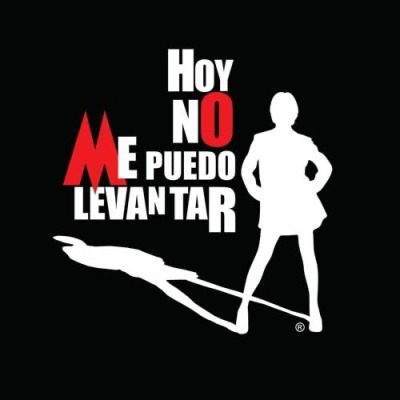
#do you know this musical#musical theater#poll#hoy no me puedo levantar#nacho cano#josé maría cano#david serrano#jukebox musical#language: spanish
18 notes
·
View notes
Text

#Vogue Ukraine#Vogue#November 2017#2017#David Ferrua#Tania Rat Patron#Yoann Fernandez#Sandrine Cano Bock
9 notes
·
View notes
Text






5 notes
·
View notes
Text
The Paranormal Tourist
We all approach the paranormal from different angles, some of us serious about research, but sometime we just want to enjoy a haunted location and be a paranormal tourist.
(more…)

View On WordPress
2 notes
·
View notes
Text

Take me for a ride please David!
3 notes
·
View notes
Text
Feilberg is forgotten but the series, with the sardonic title "The Way We Civilise", is famous because here, the barbarity of the system was laid bare in unforgettable detail. Feilberg's opening salvo has been celebrated ever since:
This, in plain language, is how we deal with the aborigines: On occupying new territory the aboriginal inhabitants are treated in exactly the same way as the wild beasts or birds the settlers may find there. Their lives and their property, the nets, canoes, and weapons which represent as much labor to them as the stock and buildings of the white settler, are held by the Europeans as being at their absolute disposal. Their goods are taken, their children forcibly stolen, their women carried away, entirely at the caprice of the white men. The least show of resistance is answered by a rifle bullet; in fact, the first introduction between blacks and whites is often marked by the unprovoked murder of some of the former – in order to make a commencement of the work of "civilising" them . . .
A few have always protested in the name of humanity against such treatment of human beings, however degraded. But the protests of the minority have been disregarded by the people of the settled districts; the majority of outsiders who take in no part in the outrages have been either apathetic or inclined to shield their companions, and the white brutes who fancied the amusement, have been murdered, ravished, and robbed the blacks without let or hindrance. Not only have they been unchecked, but the Government of the Colony has been always at hand to save them from the consequences of their crime.
"Killing for Country: A Family History" - David Marr
#book quotes#killing for country#david marr#nonfiction#carl feilberg#the way we civilise#indigenous australians#aboriginal australian#personal property#net#canoe#weapon#buildings#colonization#settlers#murder#amusement#killing
0 notes
Photo

1 note
·
View note
Text
Redacted audio as things me and my friends have said;
“It is my god damn car, we will listen to weezer if I want too,” -Darlin
“On a scale of one to ten how mad would you be if I grabbed your tits?” -Babe
“Zero, get the hell over here baby girl,” -Asher
“If you don’t want me to ride you ass don’t do stuff that’s ass-rideable,” -David
“We all agree that man slaughter is horrible-“ -Doc
“I don’t.” -Hush
“Wow, the mommy issues ain’t mommying today.” -Lasko
“Hey siri, what does ‘raw-dogging’ mean?” -Lovely
“God, I feel like I just had a lobotomy-“ -Freelancer
“You just ate a slice of cheese cake???” -Damien
“Cheesecake lobotomy.” -Freelancer
“Orgy’s are basically like clown cars but for sex.” -Gavin
“Canoes aren’t good for sex, and there are killer werewolves around.” -Gavin
“It’s a sexual position attributed to the 1985 film Back to the Future!” -Freelancer
“Ugh! Who did that? Who just crashed my car?” -Vincent
“I dunno, but he sounds like a very handsome individual.” -Lovely
“So you can go on about your nipples but me talking about eating biceps for dinner is too much for you?” -Angel
“I’m a dentist. Please put your penis away. There are no teeth down there; I checked.” -imp!sam
#redactedasmr#redacted headcanons#redactedverse#redacted audio#redacted asmr#redacted darlin#redacted angel#redacted babe#redacted asher
205 notes
·
View notes
Text
The Terror: When, How, Where... (PART 1)

See part 2 for the end of my sanity (ep 6 through 9. Wasn't enough characters left on the post for ep 10)
See part 3 (and episode 10)
As I am writing the fic, I was getting frustrated at trying to figure out the timeline of the expedition. More specifically, what happens after they dropped the Victory Point Note.
Therefore, in order to organize my ideas, and also because it might be of interests to some of you, I will document here what I got.
Episode 1 through 5 for now.
Methodology
If we agree that the showrunners (and Dan Simmons to an extent) made their research, we should be able to match some of the event of the story with notable point of interests where artefacts and/or remains were found over the numerous searches made to ascertain the fate of the Franklin Expedition
I also tried to take note of all indications of time passing so that I might document their speed travel and the dates when they are not mentioned.
... And the death count. (Departing Beechey Island with 24 officers and 102 men)
Finally, I also used the following website to keep track of sunrises and sunsets: https://www.timeanddate.com/
1927 Admiralty Map
I may be an amateur in this kind of research but I find myself frustrated that the most complete map I've been able to find showing all that was found between 1850 and 1926 is shown on this map from 1927

To be noted, we now know that the Skeleton of H. Peglar was more probably W. Gibson or T. Armitage
The Skeleton of Lt. Le Vesconte has also been reevaluated and is now believed to be that of Harry Goodsir ( :( )
Also, as it happens, if we compare to 2024 maps, we can say that this is not the actual shape of KWI (close enough!).
Therefore, for my own sanity, I recreated with modern maps. Is it accurate? Well, I wouldn't publish it but I think it gives a good enough view of where they went and where they were going:
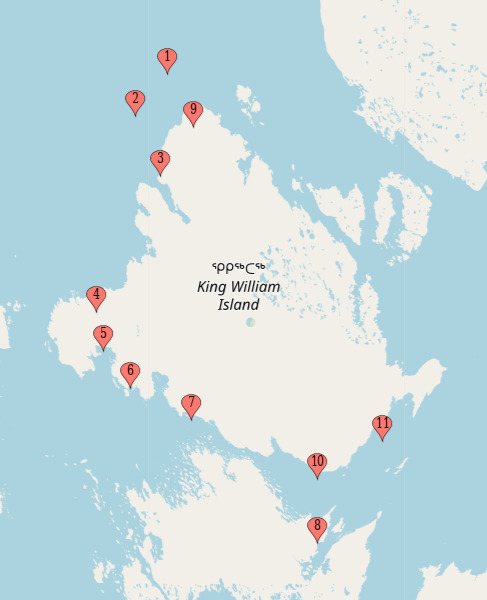

Where the Ships had drifted to in June 1847 (According to G. Gore's coordinates left on the Victory point note)
Where the Ships had drifted with the Pack by April 1848 (Victory Point Note)
Victory Point
McClintock's Boat Place (proposed to be same location as NgLJ-1)
Camp with Many skeletons
From D. Simmons' The Terror - The Hospital Camp
Peglar Skeleton
Starvation Cove
A Bunch of cairns in the area
Harry Goodsir
Gjoa Haven (Netsilik Settlement)
Fort Resolution (Dear God... look at how far they wanted to walk/Canoe/make portage...)
Matching the Show
Episode 1 - Go for Broke
Location 1 - David Young's grave (71.22, -96.60)
Date: September 5th 1846
Nighttime - None
Daylight - 14h 57 min
Twilight - 9h 03 min
Sunset: 7:51 PM - Sunrise: 4:55 AM
David Young was buried 7 days before they were beset in the ice (see point 3 on the map below).
During the dinner in which we were regaled by the tale of Mr. Fitzjames' Holes, Franklin discuss that they were approaching a bigger channel, which is now know as the McClintock Channel (see point 1 on the map below), meaning that at the time, they were still in the Franklin Strait.
On the day after his death, Franklin discuss their next course and assure that they must be 'nearly in sight of KW Land'. Crozier suggests it might take them weeks to actually make it to KWI. This would confirm what was infer above.
As we can see the two ships fitting in a cozy little cove while the grave is being dug, I would like to propose Point 4 on the map below as Ficitonal David Young's final resting place, on Tasmania Islands
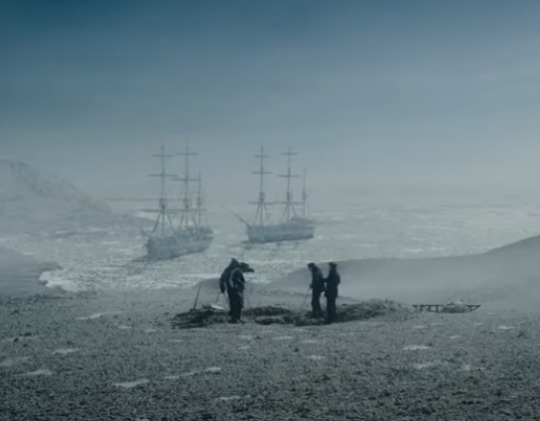
Location 2 - Ships September 1846 (70.25, -98.00)
Date: September 12th 1846
Nighttime - None
Daylight - 13h 45 min
Twilight - 10h 15 min
Sunset: 7:19 PM - Sunrise: 5:34 AM
Well, for this one, we need to use the extrapolation provided by the 1927's Admiralty map by tracing the line from where the ships were known to be in 1847 and 1848 (Point 5 and 6). (see point 3)


For Future Reference:
Travel Time between Loc 1 and Loc 2 - 7 days
Distance between Loc 1 and Loc 2 :70 NM / 80 Miles / 130 km
Average Travel Speed - 11.4 miles a day
Travel Condition - Ice breaking
DEATH COUNT: 2 + 3 (Total 5)
24 Officers and 100 Men remaining
Episode 2 - Gore
Location 3 - The Ships in 1847 (70.15, -98.30)
Date: May 24th 1847
Nighttime - None
Daylight - 24h min
Twilight - None
Sunset: N/A - Sunrise: N/A
Coordinates and Date From the Victory Point Note (see Point 1)
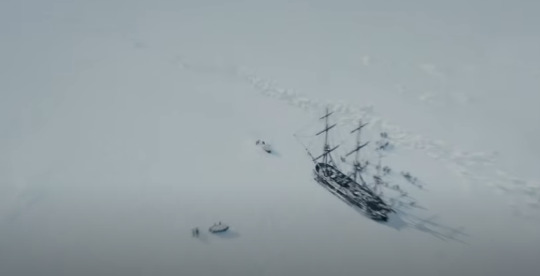
Location 4 - The Cairn (69.66, -98.27)
Date: May 28th 1847
Nighttime - None
Daylight - 24h min
Twilight - None
Sunset: N/A - Sunrise: N/A
From the ships, Gore lead his party to James Clark Ross' Cairn.
Now, in the Show, they found JCR's Cairn without an issue. In reality, while Gore had found the Cairn just fine, Crozier and Fitzjames did not. One of the reason for it is that JCR had, apparently, made a miscalculation in reporting where he had erected the Cairn by several miles. Honestly, the way that Fitzjames had written the words was so confusing, I appreciate that the show made the whole thing so much simpler, ahah. So let's say that it matches what we know now as Victory Point. Easy Peasy! (see Point 2)
To be Noted, we know the dates of departure from ships and arrival at cairn from the Victory Point Note.

Location 5 - The Ice Camp (69.665, -98.32)
Date: May 28th 1847
Nighttime - None
Daylight - 24h min
Twilight - None
Sunset: N/A - Sunrise: N/A
The Camp was raised just beyond the ice ridge that blocked the way form the shore and the Cairn was only a mile or so away. (see Point 3... hidden between point 2)
Of Note: That hail storm's cloud coverage was intense to say the least... So dark :')

Back to Loc 3 (70.15, -98.30)
Date: June 2nd 1847
Nighttime - None
Daylight - 24h min
Twilight - None
Sunset: N/A - Sunrise: N/A
Wednesday is a good day to drink with the Captain :D which makes it the Wednesday following May 28th 1847! So it's June 2nd!
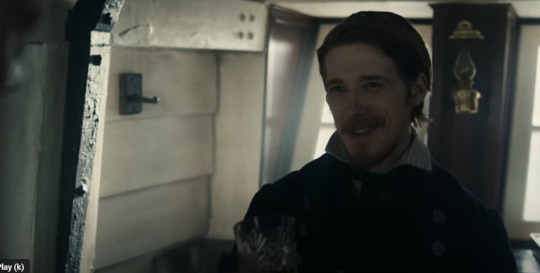
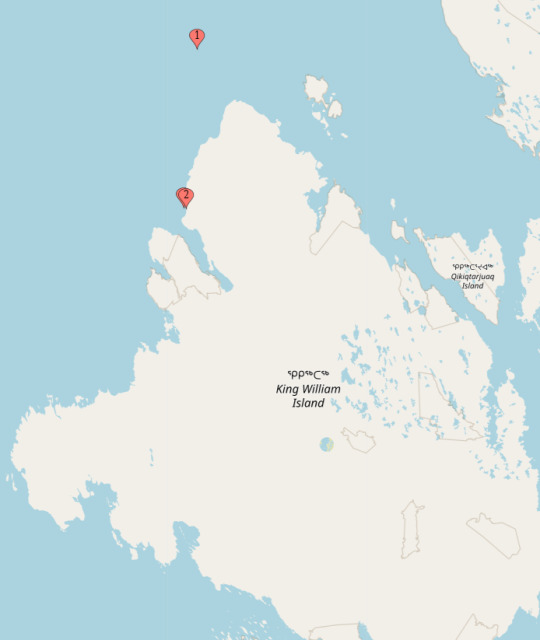
For Future Reference:
Loc 2 to Loc 3
Travel time - 8 months, 12 days or 254 days
Travel Distance: 8.6 NM / 10 miles / 16 km
Average Travel Speed - 0.04 miles a day
Travel Condition - Pack drifting
Loc 3 to Loc 4/5
Travel time - 5 days
Travel Distance: 29 NM / 33.5 miles / 54 km
Average Travel Speed - 6.7 miles a day
Travel Condition - 6 Men hauling Sledge on Ice
Loc 4/5 Back to Loc 3
Travel time - 4 days
Travel Distance: 29 NM / 33.5 miles / 54 km
Average Travel Speed - 8.4 miles a day
Travel Condition - 6 Men hauling ASS and Sledge on Ice
DEATH COUNT: 1 (Total: 6)
23 Officers and 100 Men remaining
Episode 3 - The Ladder
This one is fun because, well... they're not moving! I could point out where Silna ends up but it looks like she remain close enough to the ships that it doesn't matter all that much. So, let's just make note of the date and events:
Location 3 - Ships in June 1847 (70.15, -98.30)
For the duration of the episode:
Nighttime - None
Daylight - 24h min
Twilight - None
Sunset: N/A - Sunrise: N/A
Date: between June 2nd and June 10th 1847
- Silna makes her igloo a few miles away from the Ships
Date: June 11th 1847
- Franklin Dies
- Crozier drafts his resignation letter
Date: June 12th 1847
- Franklin's leg is buried :')
- Lieutenant Fairholme is sent to KWI.
DEATH COUNT: 2 (Total: 8)
22 Officers and 99 Men remaining
Episode 4 - Punished, As a Boy
Another fun bottle Episode!
Location 3 - Ships in same approx position as June 1847 (70.15, -98.30)
Date: November 23rd 1847
Nighttime - 12h 35 min
Daylight - None
Twilight - 11h 25min
Sunset: 11:47 am - Sunrise: 10:51 am
- William Strong's birthday :)
- We know because it's the last sunrise of the year!
- Evans and Strong die :(
They searched for a long time if it was just before 4 pm when they got the alarm and then they came back in time for last sunrise at 11 am...
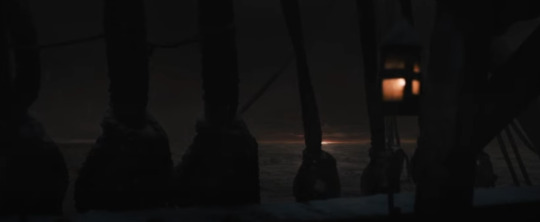
Date: November 24th 1847 to November 25th 1847
Nighttime - 12h 35 min
Daylight - None
Twilight - 11h 25min
Sunset: N/A - Sunrise: N/A
- Hickey has a communion with Tuunbaq (supposedly next day or so)
- Then Hickey gets evily booped.
DEATH COUNT: 2 + Hickey's postern (Total: 10)
22 Officers and 97 Men remaining
Episode 5 - First Shot the Winner, Lads
More fun in a bottle. These boys are not going far...
Honestly, for this one, the trouble was figuring out how much time had passed. For one, we know it's not yet Christmas because Christmas is, in fact, mentioned in Episode 6 (And Lady Jane's Christmas Pudding, hear hear) as part of the meeting between the officer and there was not yet a cooperation between the Terror Lts and Fitzjames for counting the supplies.
ALSO! That scene where Mr. Wentzell got killed dead over his nail... well, it gave me the feeling that either the review of the crew is not daily or that they've been on Erebus for a short time because 1) Fitzjames doesn't know their names and 2) He has to repeat the instructions about cleanliness... Perhaps they sent the Terrors in waves and not all 50 of them at once.
Other details to be mentionned:
Hickey is not recovered yet and Goodsir suspects he might reopen his wounds from working.
Goodsir has had time to be quite good at speaking inuktitut. Now, he could have had a continuous learning experience from Dr. McDonald since June 47 and before but considering that Dr. McDonald is stationed in Terror and Goodsir in Erebus, I suspect they did not have much time to have a class together...
Finally. Crozier suggests that he would be 2, perhaps, perhaps more... sick from sobering up. He got up just in time for First sunrise (Jan 17th).
So! We can infer that the episode might have spanned over 1 or 2 days (what's with the movement between the ships and the whole Rat Wedding).
My best guess is that the dates for this whole episode would be:
Date: December 14th 1847 to December 18th 1847
Nighttime - 13h 32 min
Daylight - None
Twilight - 11h 28min
Sunset: N/A - Sunrise: N/A
Why December 14th? Because it would be Edward Little's Birthday and I feel like it is appropriate for his character to have his boss send him back to the killing cold for more booze :') (December 16th to December 20th seems more likely but...)

This would give Crozier a full month to recover from sobering up and 22 days for Goodsir to learn inuktitut (impressive!), for Hickey backside to feel better and for Fitzjames to NOT learn the name of his new Terrors.
DEATH COUNT: 3 + Blanky's leg (Total: 13)
22 Officers and 94 Men remaining
That's it for now. I'll do the last 5 episodes soonish...
Conclusion to the first sets of episode: Sunsets and Sunrises were whacky in June 1847 but, so far, distance and travel times make good sense. If the accuracy holds up until episode 10, we might be able to have a pretty good idea of what, when and where everything happened in episodes 6 through 10.
#The Terror#The Terror AMC#Reference#The Terror Timeline#19th century dead sailors#At least now it's written somewhere that is not 120301923 word files...#Might need later editing#Super duper long post
39 notes
·
View notes
Text
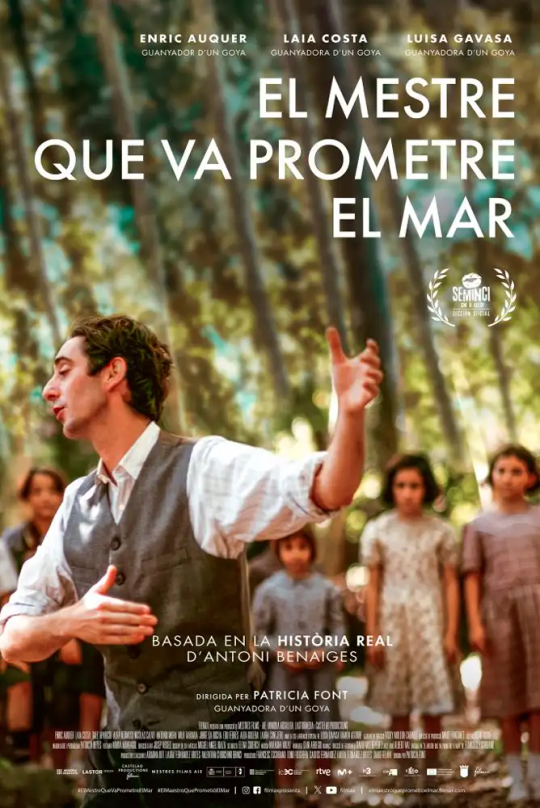
youtube
Period dramas- El Mestre Que Va Prometre El Mar (The teacher who promised the sea) (2023)
7,7/10 ⭐ on IMDB
The film focuses on the life of Antoni Benaiges , a teacher from Mont-roig del Camp, in the Baix Camp, in Tarragona, Catalunya, who in 1935 was sent to the public school in Bañuelos de Bureba, a small town in the province of Burgos, Castilla la Vieja (Castilla y León). Little by little, and thanks to a pioneering and revolutionary teaching methodology for the time, he will begin to transform the lives of his students, but also that of the town, which is not always to everyone's taste.
It's based on the book of the same name by Francesc Escribano and has been adapted for the big screen by Albert Val, and its director is Patrícia Font.
To tell the story of Antoni Benaiges (Enric Auquer), the film interweaves past and present and the master's story will be known through the eyes of Ariadna (Laia Costa), a woman looking for her great-grandfather who disappeared during the Civil War.
The producers of the film wanted to emphasize the essence of this exciting story: " 'El mestre que va prometre el mar' is a great story that has been unfairly forgotten for many years. With this film we are repairing an oblivion and at the same time valuing the work of the republican teachers and recognizing the struggle of so many people who still continue to search for their relatives buried anonymously in mass graves. An exciting and fully valid story.
Part of the technical team is made up of David Valldepérez, director of photography; Josep Rosell, art director; Dani Arregui, editor, and Natasha Arizu, composer, among other professionals.
The film is shot for six weeks in various locations in the demarcation of Barcelona, in Mura, and in Briviesca (Burgos). It is a production of Minoria Absoluta, Lastor Media, Filmax and Mestres Films AIE.
RTVE and TV3 participate and it has the support of the ICAA and the ICEC . Filmax is in charge of distribution to cinemas.
Length: 1 h 45 min
Premiere: November 10th 2023
Cast
Enric Auquer: Antoni Benaiges
Laia Costa: Ariadna
Luisa Gavasa: Charo
Ramón Agirre: Adult Ramón
Gael Aparicio: Carlos
Alba Hermoso: Josefina
Nicolás Calvo: Emilio
Antonio Mora: Mayor
Milo Taboada: Priest Primitivo
Jorge Da Rocha: Camilo
Eduardo Ferrés: Rodríguez
Alba Guilera: Laura
Laura Conejero: Rosa
Xavi Francés: Education inspector
David Climent: Falangist Chief
Felipe García Vélez: Adult Carlos
Elisa Crehuet: Adult Josefina
Padi Padilla: Encarna
Alicia Reyero: Ángeles
Gema Sala: Jacinta
Alía Torres: Ariadna's daughter
Carlos Troya: Bernardo Ramírez
Arnau Casanovas: Portraitist
Laura Gaja: Elvira
María Escoda: Juana
Chus Gutiérrez: Archivist
Joan Scufesis: Sergio
Cristina Murillo: Residency nurse
Sara Madrid: Hiker
Pep Linares: Falangist waiter
Albert Malla: Radio announcer
Izan Barragán: Leandro (School boy)
Didac Cano: Casimiro (School boy)
Hernán Gracia: Eulogio (School boy)
Noa Guillén: Asunción (School girl)
Ona Macía: Saturnina (School girl)
Elena Moreno: Dionisia (School girl)
Gal-La Petit: Hilaria (School girl)
Genís Lama: Falangist
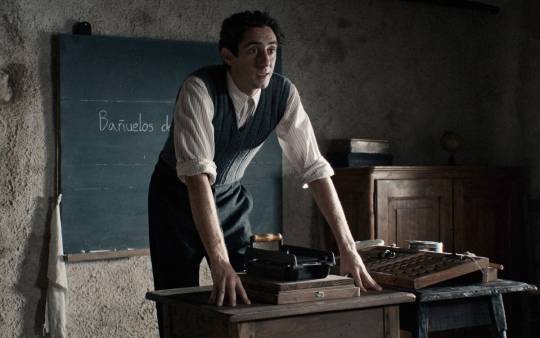



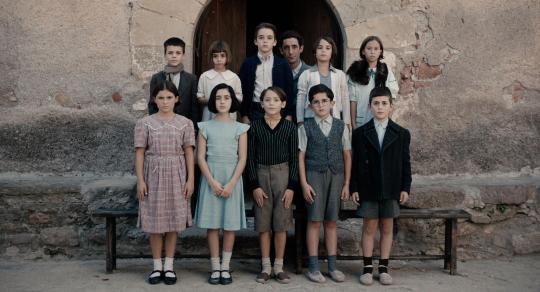
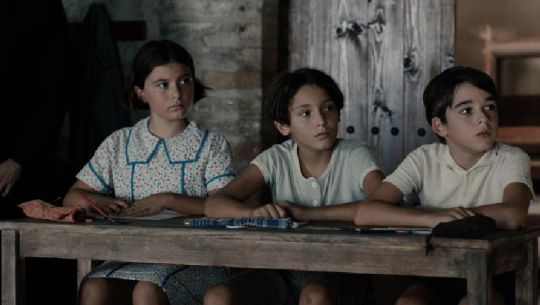
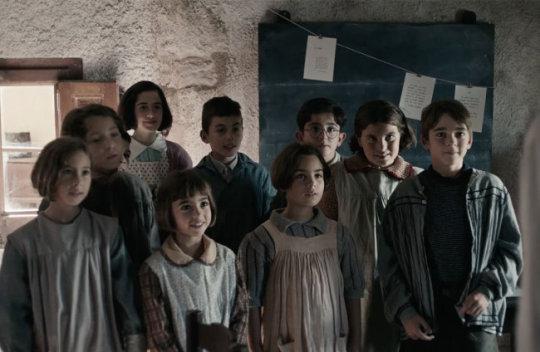
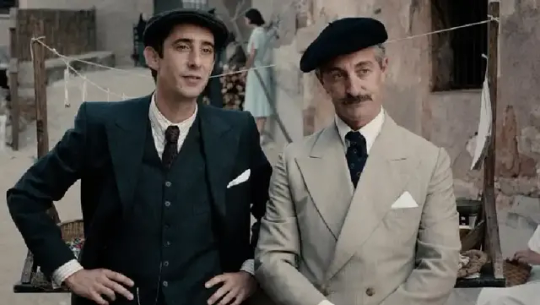

#el mestre que va prometre el mar#the teacher who promised the sea#films#period dramas#Youtube#enric auquer#laia costa#luisa gavasa#ramón agirre#gael aparicio#alba hermoso#nicolás calvo#antonio mora#milo taboada#jorge da rocha#eduardo ferrés#alba guilera#laura conejero#xavi francés#david climent#felipe garcía vélez#antoni benaiges#elisa crehuet#padi padilla#alicia reyero#gema sala#alía torres#carlos troya#arnau casanovas#laura gaja
32 notes
·
View notes
Text


David Cano Lemus 🇬🇹
21 notes
·
View notes
Text
valley of woodwinds canine
as for the punctual starling
what will it make of your size six shoes
tiny canoes
that much smaller without you
will it build a home in the heel
confide with a single note
the forfeit of all things to the forest
the clouds are warships
stealing amethyst from its plume
what does a starling make
of unseen workings
germane & sacred
of bodies transformed
of collaborations with the soul
a divine premonition
somehow a threshold confessor
the moat of its eye
unfortified
yields a broken levee
please
look favourably on its attempt
somewhere in the quill of its song
the hollow of a hebrew word
spares a god’s fatigue
that leaf
rocking a cradled goodbye
just the wind mocking a human gesture
the spring of such antics
the pendulum of a bird’s tail
how did we stray so far into the feral
& think we’d be safe
lilies were stargazing long before this
before this
you were indestructible
but no bargain exists
between the sick & a poisonous thistle
she is haunted like a newborn burgundy
dressed in the pyjamas of the departed
the bird has lost its call
the bird is a hammer
tapping a fault line
tapping an amputated smile
an algorithm to wake an android child
you'll find him at the foot of a ruse
toes in the gloaming
rehearsed in the dolour of others
his marrow arm
carrying a firefly’s cradle
your cheek
a flushed stone pulled from orbit
the body’s earthquake
the unbroken lung
internal fleets
speaking animal frequencies
have you seen the mother of loneliness
her woeful bay
calling for the scruff of grief
©️david sichler
64 notes
·
View notes
Photo
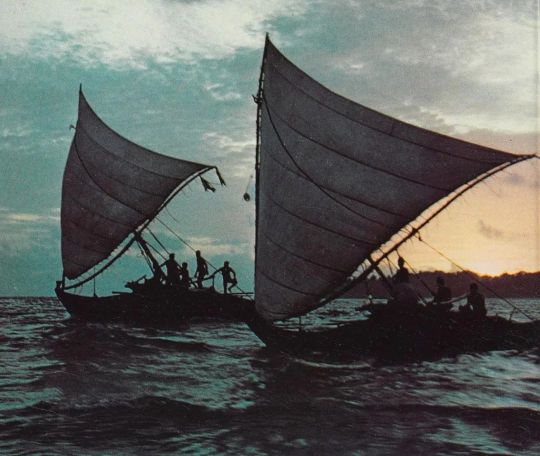
Satawal Islanders, 1962. Photo by David S. Boyer. "Sails set high at sunrise, Satawal Islanders beyond the horizon. These residents of small atolls between Yap and Truk in the western Pacific sail hundreds of miles in outriggers made from breadfruit planks. Canoes bore voyagers to distant Pacific island homes centuries before Columbus braved the Atlantic, perhaps even before the birth of Christ. Shallow draft enabled their boats to get through coral reefs; stability came from a light float attached to the bull with booms, or by a second bull connected by a platform. Double canoes of Tonga, largest known in Polynesia, reached 100 feet and carried as many as 200 voyagers. Some were built of planks stitched together with cord made from the fibrous bark of the purau tree. Paddles, and mat-like sails woven from pandanus leaves, propelled them." From "Men, ships, and the sea" by Alan Villiers, 1978. https://www.instagram.com/p/CpQhoKatjRw/?igshid=NGJjMDIxMWI=
133 notes
·
View notes
Text
What Mythical Creature are they?
Masterlist
Resourcess:
Dwayne: Sisiutl
David: Gremlin
Marko: Byssus Galeto/Bisso Galetos
Paul: Näcken
Dwayne: Sisitul (Native American)
Since Billy Wirth is Native, I thought researching Native American creatures was the best option. I chose the Sisiutl since it's not depicted as evil and instead a protector. I feel like this is similar to Dwayne's relationship with Laddie. Personally, I believe that Dwayne is the least "evil" of the boys, he's just more into going with the flow when finding a meal instead of toying with them. During the movie, he also neve outright attacks anyone except Sam, at the end of the movie. This can relate back to the Sisiutl being protectors since Dwayne was protecting his family.
The Kwakwaka'wakw tribe depicts the Sisiutl as a tri-headed serpent, with two snake heads on either side of a human one in the middle. Shaman believed its blood would transfer healing magic into a person. Warriors adorned the image for protection, believing that the blood would make them invincible in battle. Sometimes, the faces of the Sisiutl were carved into entrances or canoes to ward off evil spirits. Others believed that mica, the mineral found in soil and beaches, were the scales of the Sisiutl.
David: Gremlin (British/American)
David is a nasty little Gremlin throughout the film. These creatures are described as mischievous and hate the light, which is fitting for David. He is the only reason that the movie happened, without him creating these mischievous problems, Micheal would've never met Star or had to help kill Max. Also, the aversion to light is pretty aligned with Vampires. David is definitely the type to push everything three inches to the left so that someone bumps into everything.
Gremlins were seen in mainstream culture around the beginning of the early 20th century. Originally, they were blamed for the malfunctions in aircraft and later on in other machinery. There was a large prominence of "Gremlins" during WWII in posters regarding safety in the workplace. Captions such as "Gremlins LOVE to pitch things at your eyes," "Gremlins are floor greasers," and "Gremlins will push you around. Look where you're going," warned the workers about the consequences of not cleaning or doing their job properly.
Marko: Byssus Galetus (Italian)
I chose a creature from Italian folklore since I headcanon that Marko is Italian. A creator who I don't remember the name of originally headcanons him and Italian and I agree. The Byssus Galetus is a spiteful creature hailing from the Veronese Valleys in Verona, Italy. The creature has the head and body of a rooster (galetus) with wings full of thorns and a snake's tail (byssus). I chose this for Marko since they're born from spite and live that way. You cannot tell me that Marko would not go out of his way to be full of hatred and spite in his life and afterlife. Also, Marko is seen playing with pigeons in the movie, which in my mind, help connect him to the Byssus Galetus because it's half chicken.
While they're small creatures, the Byssus Galetus is an incredibly poisonous creature. They wander into houses at night and kill people with their toxic breath. The gaze of the creature can dry out and kill plants, along with contaminating water. It's said that the Byssus Galetus is laid by an elderly rooster and hatched by a snake or toad for nine years. If a Byssus Galetus sees it's own image it dies.
Paul: Näcken/Strömkarl (Swedish)
While Brooke McCarter isn't Swedish, I headcanon that Paul is. He's tall, blond, and it literally built like a Viking. The Näcken are male water spirit found by lakes, streams, or other bodies of water. They play enchanting music to lure their victims to the water and drown them. However, some believe that the water spirits are harmless and if approached properly, teach a musician to play perfectly. The Näcken come mostly from Germanic and Scandinavian folklore.
I chose the Näcken for Paul since most media depicts Paul with a rockbox or some other instance of music. If you didn't know, Brooke McCarter is a composer and has multiple songs and is listed as the composer for the documentary America the Violent. I headcanon that Paul is a really good singer and has learned to play instruments throughout the years, which leads to his love of music.
#the lost boys#tlb#the lost boys 1987#tlb 1987#david the lost boys#david tlb#david the lost boys 1987#david x reader#david tlb x reader#dwayne the lost boys#dwayne tlb#tlb dwayne#dwayne x reader#dwayne tlb 1987#dwayne the lost boys 1987#paul lost boys#paul tlb#paul x reader#the lost boys paul#tlb paul#paul the lost boys 1987#marko the lost boys#marko the lost boys 1987#marko tlb#marko x reader#sam emerson#sam tlb#sam the lost boys#sam the lost boys 1987#michael the lost boys
9 notes
·
View notes
Text
from my bookshelf
Pytheas of Massalia was a Greek geographer, explorer and astronomer from the ancient Greek colony of Massalia — modern-day Marseille, France. In the late 4th century BC, he voyaged from there to northwestern Europe, but his detailed account of it, On The Ocean, survives only in fragments, quoted — and disputed — by later authors such as Strabo, Pliny and Diodorus of Sicily. The Extraordinary Voyage Of Pytheas the Greek by the noted British historian of ancient maritime Europe, Barry Cunliffe, attempts to draw out the reality of what was an extraordinary sea journey, from the Western Mediterranean north along the Atlantic coast of Europe to the British Isles, then even further north, to the near-mythic land of Thule. Cunliffe makes a strong case for Pytheas being “the first European explorer”, while identifying the most likely locations of Thule, sought so avidly by 19th and early 20th century adventurers and artists.
James Hamilton-Paterson’s Seven-Tenths: The Sea And Its Thresholds, published in 1992, more than two thousand years after Pytheas’s On The Ocean, is an ambitious, expressive exploration of the vast aqueous wilderness that covers three-quarters of our planet by a writer of remarkable literary accomplishment (he was one of Martin Amis’s professors at Oxford). Plumbing humanity’s complex, multi-faceted relationship with the sea, Hamilton-Paterson writes vivid, meditative passages about, well, everything — fishing, piracy, oceanography, cartography, exploration, ecology, the ritual of a burials at sea, poetry, and even his own experiences living for extended periods on a small island in the Philippines.
Tom Neale’s autobiography, An Island To Oneself: Six Years On A Desert Island, describes an altogether smaller, more solitary world: the island of Anchorage, part of the Suwarrow Atoll in the South Pacific. Born in New Zealand in 1902, Neale spent most of his life in Oceania: after leaving the Royal New Zealand Navy, he worked for decades aboard inter-island trading vessels and in various temporary jobs ashore before his first glimpse of his desert island home. He moved to Anchorage in 1952 and over three different periods, lived in hermitic solitude for 16 years, with rare visits from yachtsmen, island traders, and journalists. Among the last was Noel Barber, a close friend of my late father: he gave my father a copy of Neale’s book, in Rome, shortly after it was published in 1966 (I still have it). Neale was taken off his beloved island in 1977 and died not long after of stomach cancer.
The Starship And The Canoe by Kenneth Brower, published in 1978, is an unlikely dual biography of a father and son that draws intriguing parallels between the ambitious ideas of renowned British theoretical physicist and mathematician Freeman Dyson — who, in the early 1970s explored concepts for interstellar travel, settlements on comets, and nuclear rockets that might propel mankind to the outer reaches of the universe — and his wayward son, George, who lived in a self-built tree house 30 metres up a Douglas fir overlooking the Strait Of Georgia, in British Columbia and devised large canoes based on Aleut baidarkas in which to paddle north to the wild, uninhabited littoral of southern Alaska. Brower’s descriptions of long passages with the younger Dyson in the cold, sometimes fierce tidal waters between Vancouver Island and the Canadian mainland are gripping and I have read them again and again. It is, unarguably, my favourite book.
The late, New Zealand-born doctor and sailor, David Lewis, is not as widely known as he was half a century ago, even by avid readers of sea stories, but from his earliest memoirs in the 1960s — of his participation in the first-ever singlehanded trans-Atlantic race (The Ship That would Not Sail Due West), and of incident-prone voyages to far-flung coasts with his young family (Dreamers of the Day, Daughters of the Wind, and Children Of Three Oceans) — to his practical, first-hand studies of instrument-less ocean navigation among South Pacific islanders, (We, The Navigators and The Voyaging Stars) in the 1970s, Dr. Lewis was not only the late 20th century’s most remarkable and intelligent writer on the sea and small-boat voyaging but also one of its most adventurous. My favourite of his several books: Ice Bird, published in 1972, an account of a gruelling, almost fatal voyage from Sydney, Australia, in an ill-prepared, steel, 32-foot yacht to achieve the first singlehanded circumnavigation of Antarctica.
It’s said that spending time anywhere with Lorenzo Ricciardi, late ex-husband of Italian photographer Mirella Ricciardi, was an adventure. A film-maker and former senior advertising executive, once described by a British writer as “a penniless Neapolitan count”, he gambled at roulette to raise enough money to buy an Arab dhow, which, in the 1970s, with little seafaring experience and plenty of mishaps, he sailed from Dubai to the Arabian Gulf, and from there down the Arabian to coast of Africa, where the dhow was shipwrecked among the Comoros Islands. The Voyage Of The Mir El Ah is Lorenzo’s picaresque account (illustrated by Mirella’s photographs). Astoundingly, several years later, Lorenzo and Mirella Ricciardi completed an even more dangerous, 6,000-kilometre voyage across Equatorial Africa in an open boat — and another book, African Rainbow: Across Africa By Boat.
Italian madmen aside, it used to be that you could rely on surfers for poor impulse control and reckless adventures, on the water and off. Back in the late 1990s, Allan Weisbecker sold his home, loaded his dog and a quiver of surfboards onto a truck, and drove south from the Mexican border into Central America to figure out what had happened to an old surfing buddy — in between checking out a few breaks along the way. In Search Of Captain Zero: A Surfer's Road Trip Beyond The End Of The Road is a memoir of a two-year road-trip that reads like a dope-fuelled fiction but feels more real than William Finnegan’s somewhat high-brow (and more successful) Barbarian Days: A Surfing Life.
Which brings me to Dana and Ginger Lamb. In 1933, these newly-weds would certainly have been looked at askance by most of their middle-American peers when they announced that they weren’t ready yet to settle down and instead built a 16-foot hybrid canoe-sailboat and set of on what would turn out to be a 16,000-mile, three year journey down the Pacific coasts of Mexico, Guatemala, Salvador, Nicaragua and Costa Rica to the Panama Canal. Dana’s 415-page book, Enchanted Vagabonds, published in 1938, was an unexpected New York Times best-seller and today is more exciting to read than the ungainly, yawn-inducing books produced by so many, more commercially-minded, 21st century adventurers.
First published in Sirene, No. 17, Italy, 2023.
10 notes
·
View notes